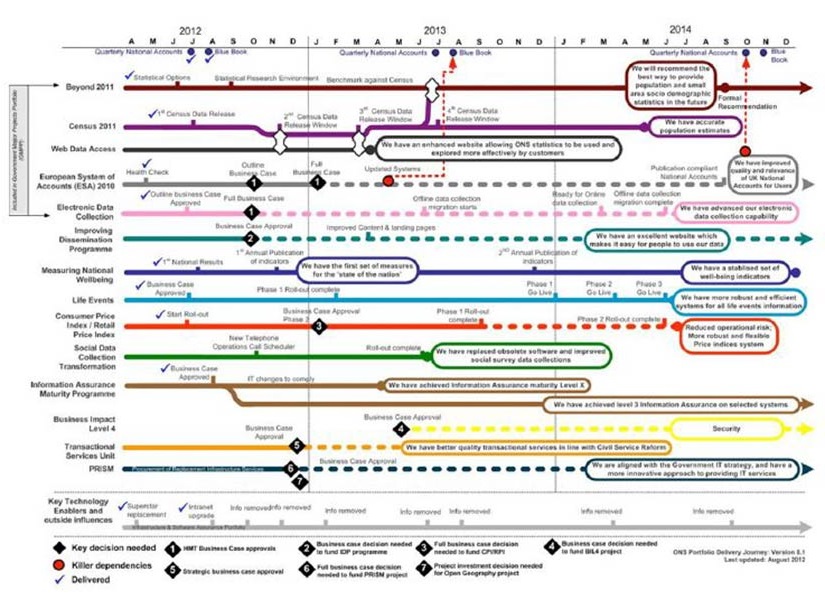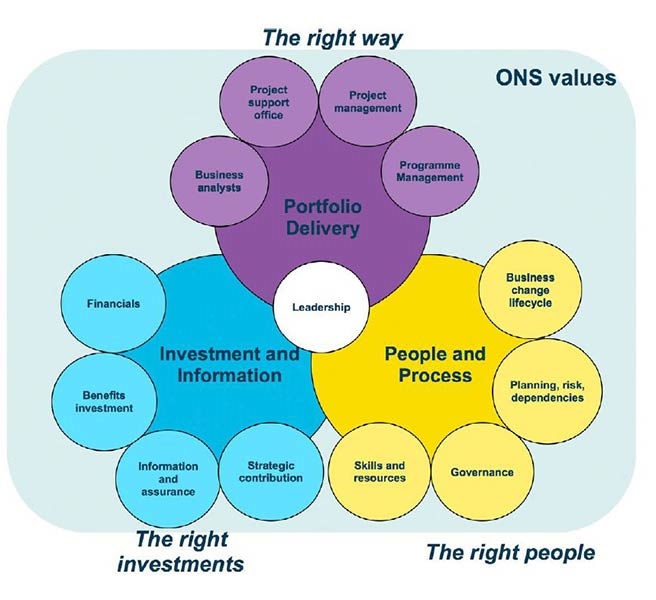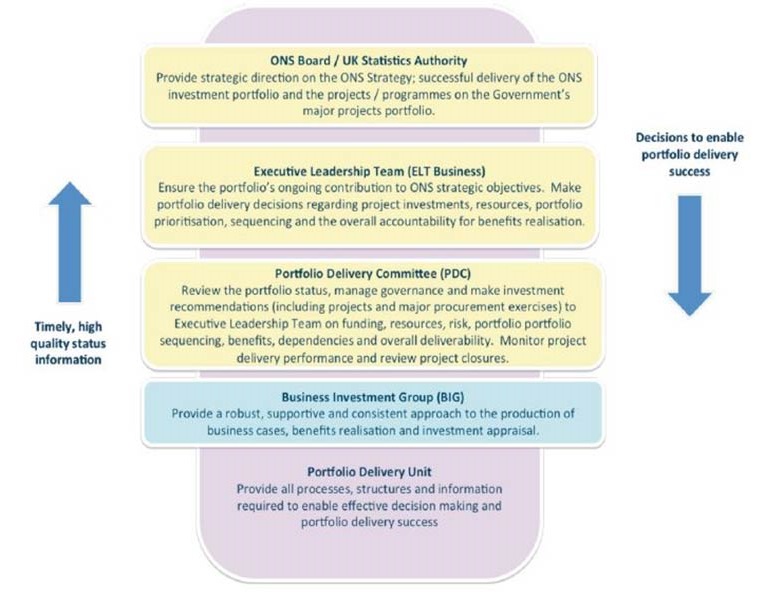How to implement Management of Portfolios within 100 days Case Study
Case Study


Case Study

- Case Study
- Portfolio management
- Stakeholder management
- MoP
May 30, 2013 |
17 min read
- Case Study
- Portfolio management
- Stakeholder management
- MoP
All of our White Papers and Case Studies are subject to the following Terms of Use.
The Office for National Statistics (ONS) collects, analyses and publishes important statistics such as population, inflation and gross domestic product. This information is used to inform decisions that affect the lives of everyone in the UK. In 2012, ONS recognized that a portfolio management approach to business change was required, to prioritize investments which would contribute most to strategy in the face of rapidly evolving technology and an increasingly complex society.
Introduction from the Director General
At the Office for National Statistics (ONS) we collect, analyse and publish important statistics such as population, inflation and gross domestic product. This information is used to inform decisions that affect your life and the lives of everyone in the UK.
In 2012, we recognized that a portfolio management approach to business change was required to ensure we prioritized and invested in the changes that contribute most to our strategy.
We were aware that some studies indicated a timescale of 12–18 months to implement portfolio management. However, we decided to embark on a 100-day, high-energy approach to implementing AXELOS' best-practice standard Management of Portfolios (MoP®; The Stationery Office, 2011). During the implementation we derived considerable value from enhanced executive portfolio-level information, portfolio prioritization, consistent portfolio investment appraisals and project sequencing. All of this led to a greater understanding of the portfolio delivery landscape and the ability to make more confident investment decisions with an overall increase in collaborative working and organizational energy.
While we can’t see into the future, we do know that the landscape in which we are delivering complex change will continue to be fraught with real economic challenges, rapidly evolving technology and an increasingly complex society. This is why it is more important now, than ever before, to invest in the right projects and deliver them the right way, using the right people, every time. We believe portfolio management is critical to achieving this.
Glen Watson, Director General, Office for National Statistics
‘I am very pleased with the value we have experienced from using portfolio management. It has never been more important for departments to make informed and confident decisions regarding investments in projects and programmes.’
Jil Matheson, Permanent Secretary and National Statistician, UK Statistics Authority‘I’m very impressed with the approach ONS is taking in developing its portfolio management strategy and processes. I endorse the direction which is being taken, which is consistent with the work in which MPA is engaged in developing a Government-wide portfolio of major projects.’
David Pitchford, Executive Director, Cabinet Office: Major Projects Authority
Understanding where we were
In January 2012, a key recommendation from an organizational change programme (sponsored by the National Statistician and Director General) recommended the implementation of portfolio management across ONS. The necessary portfolio management skills did not exist within ONS and interim assistance was commissioned to deliver this capability based on the Cabinet Office’s MoP.
Value Experience
Prior to commencing work at ONS, a value experience plan was agreed with the Director General, highlighting the value that the executive leadership would experience from adopting a portfolio management approach.
Portfolio Definition Cycle
The first step focused on understanding the detail of the portfolio and the portfolio management capability. An intense 10-day consultation period followed, with more than 60 one-hour consultation meetings taking place. Meetings were attended by the entire executive leadership team, the project and programme management community, and teams from finance, IT and business areas.
Portfolio Capability Measurement
In order to understand our current portfolio management capability and set targets for the future, we created a bespoke portfolio capability model (see glossary). This was created based on MoP’s keys to success and the capability questionnaire within the Executive Guide to Portfolio Management (AXELOS, 2012).
Organizational Energy
We wanted to measure organizational energy; however, our Civil Service People Survey had just taken place, so the timing wasn’t right. Instead, during the consultation meetings we measured how happy people were with ONS’s current ability to manage change. We did this by asking people to score their happiness out of 10 (10 being very happy; see ‘happiness indicator’. The average happiness score in April 2012 was 4.3. In October we asked the same people again and the average happiness score was 6.4, an increase of 48.8%.
The outcome of the portfolio management capability assessment was represented in a spider graph. This was useful for three reasons:
- It enabled us to understand where we were already doing good things as well as areas for improvement.
- It enabled us to plot our targets for each capability area and energize people to join in.
- It became the foundation on which we built the portfolio management improvement plan.
Understanding where we wanted to go
Vision
From the outset we felt it was critical to focus on engaging people, ensuring they understood the value experienced from adopting portfolio management in ONS.
A vision statement for portfolio management in ONS was agreed as: ‘ONS successfully delivers the right projects and programmes, in the right way, with the right people, every time’. Using this vision statement in all presentations and documents helped everyone to understand where we were going.
Portfolio Management Blueprint
We found that simple, well designed graphics and diagrams were much more effective when describing the portfolio management implementation approach to people. One such product was the portfolio management blueprint shown in Appendix 1. This represented the future portfolio management, processes, collaborative working, governance and information flows in a picture on one side of A3.
Portfolio Plan
The most successful product we created was the ONS portfolio delivery journey 2012–14, shown in Appendix 2. ONS deals with extremely complex statistical systems and during the consultation one of the key areas of pain highlighted repeatedly was that people didn’t understand how their project fitted with others. So we designed a simple, eye-catching, one-page view of the whole portfolio landscape.
Inspired by Harry Beck’s iconic design of the London Underground of 1931, the ONS portfolio delivery journey 2012–14 instantly helped people understand the portfolio scope, delivery timescales, ‘killer’ dependencies (i.e. dependencies that were critically important) and key benefits. This was well received by colleagues at Her Majesty’s Treasury, Cabinet Office Major Projects Authority and Cabinet Office Efficiency Reform Group because it helped everyone understand the ONS portfolio and plan assurance resources.
Working together to get there
Portfolio Office
We used the portfolio management capability assessment and the blueprint to design the model and services of the new enterprise portfolio office – we called it a portfolio delivery unit (PDU; see Appendix 3).
A key focus for us during the design of the PDU was to ensure that it provided the services that would offer maximum value to ONS. This meant focusing on the right services and ensuring the skills of the PDU team could consistently deliver those services to the highest possible quality. With that in mind we organized the skills into three main areas which included investment and information, people and process, and portfolio delivery.
Welcome to the Portfolio Delivery Unit
Because the PDU was a new function, we put a lot of energy into helping people understand the services and value they would experience from the team. One very useful tool was a PDU welcome pack. We didn’t just email it to everyone; we wanted to create conversations so we used it during face-to-face engagement via various groups, forums, seminars and one-to-ones. It was also very useful to help new starters get up to speed with the processes and background.
Quality
The first thing to be instigated within the PDU was a check to ensure that products were great, usable, clear, concise and informative (GUCCI; see glossary). Before a product left the PDU it was checked by the team to ensure it achieved our GUCCI standard. If it didn’t, we didn’t release it.
Portfolio Governance
The PDU implementation incorporated the initial development of the governance that was used to deliver the portfolio; see Appendix 4. This included adding portfolio management responsibilities to the terms of reference of the executive leadership team meeting. We also set up a portfolio delivery committee (chaired by an executive director and attended by the chief finance officer) and a collaborative investment appraisal process known as the business investment group (BIG). We knew governance was critical to success, but also that it needs to delicately evolve with the portfolio capability and process improvement. With that in mind we made sure that we continually reviewed the value and ensured people felt comfortable with offering their feedback. Doing this ensured a collective understanding of the governance which led to increasingly consistent portfolio executive information and more confident portfolio investment decisions.
Portfolio Investments
The BIG team is a virtual team of experts within ONS who provide a support and scrutiny mechanism of new business case investments. The name BIG was appropriate, because it was memorable and focused people’s minds on investment.
Portfolio Information
One of the most recognizable enhancements from the executive perspective was the complete change in approach to executive information. Historically, large Word documents had been used. We scrapped this method and implemented a totally new style of executive portfolio information. This included less project data and more portfolio information which enabled key decisions to be made.
Executive Information
The executive leadership team was presented with the first monthly executive portfolio information pack within the first 30 days. This incorporated ‘portfolio zooms’, a new concept that provided executive leaders with an enhanced focus on specific aspects of the portfolio. This instantly added value because it focused on critical information, enhanced confidence and clearly defined the decisions required from executive leadership.
Collaboration Processes
A key enabler for enhancing executive-level information so quickly was the change we applied to the monthly project highlight reporting process. The existing highlight report template was weak and required too much effort on the part of project managers. The PDU worked with all project managers and the IT directorate’s programme management office (whose role it was to coordinate all IT aspects of projects) to redesign the format, thus ensuring higher-quality information was provided in less time.
Reporting Cycles
Because of the faster pace of portfolio delivery, a fortnightly reporting cycle was implemented across every project and sequenced with the existing reporting cycle of the IT programme management office. A ‘handshake’ document was agreed between the PDU and the IT programme management office which formed the agreed ways of working between the two teams. Such collaborative working enabled information flows to be synchronized and played a key part in bringing teams closer together. This was critical to boosting the quality and timeliness of portfolio information to the executive leadership team and ONS board.
Strategic Contribution
The PDU reviewed the benefits from every project and assessed the strategic contribution to the objectives in the ONS business plan. A weighted scoring technique was used and this formed a critical part of the information that was used during the portfolio and business-as-usual prioritization process. It was important that the PDU resource was assigned to this work on an ongoing basis, because unravelling the complexities at the same time as developing benefits management capability was crucial.
Collaborative Teams
Throughout the portfolio prioritization process, collaborative working and strong relationships between the PDU and the finance team were key to success. When information was presented to the executive leadership team valuable investment conversations took place and this enabled decisions regarding investment, efficiencies, risk and the return on investment to be made confidently.
Actively Managing Benefits
Benefits management was a main area for development. One of the key products from the business case review was the development of a portfolio-level benefits trajectory. We diagrammatically represented the extent to which various stakeholders realize benefits from ONS. While it was very useful as an initial indicator, it had many caveats in the first instance because of its sheer complexity, which meant more work was needed to qualify and assure the benefits.
Benefits Eligibility
The benefits eligibility guidance was created in line with APMG International’s Managing Benefits. It provided people with a consistent approach to managing benefits, including the definitions of various types of benefits and the investment approaches needed for different categories of projects. For example, value-for-money projects used cost-benefit analysis whereas mandated projects used cost-effectiveness analysis as the primary investment appraisal technique. This was critical to ONS because around 90% of all change within ONS is either mandated or helps other organizations make more informed decisions.
Creativity
A central philosophy in everything we did was creativity. We invested a lot of time in the design of the PDU products because we knew they would help people appreciate the value of enterprise portfolio management. Therefore, the needs of the recipient and wider audience were a key design consideration of every PDU product.
Executive Engagement
A good example of a creative approach was the first presentation to the ONS board (attended by the national statistician/permanent secretary, executive and non-executive directors). We didn’t want to write a regular report about portfolio management; we wanted something experiential that would prompt useful debates. Ahead of the meeting, the PDU came up with the top 10 questions that the ONS board would want answers to, such as ‘What is the portfolio return on investment?’. Based on those questions we created large A1 prints that graphically answered those questions based on the information we had at that time. These were presented at the meeting in the style of an art exhibition which helped people engage and gave them a glimpse of the information they would get moving forward.
PPM Skills
The development of project and programme skills was a priority for ONS. During the first 100 days, the PDU took steps towards developing a cadre of professionally recognized project and programme experts within ONS. Role profiles for project and programme managers were updated to include competencies from the Association of Project Management (APM) and these were incorporated into the plans for a project and programme management development centre.
Portfolio Delivery Community
The PDU was aware that a lot of skills, experience and passion existed within the team of project managers, programme managers, business analysts and project management offices. We felt that this wasn’t being tapped into effectively so a monthly portfolio delivery team meeting was set up to provide a forum, where all project managers could communicate, discuss challenges and share experiences.
Going beyond 100 days
More Value
Towards the end of the first 100 days, the ONS board was presented with a value experience plan for the next six months. This committed the PDU to delivering the value as defined in that plan. This was communicated to the portfolio delivery team and helped people to understand the next step in the portfolio development journey.
Better with Benefits
The draft benefits eligibility guidance was created within 100 days, and in November 2012 we ran a full-day workshop for 60 people creating initial benefits maps for all projects. This was very challenging to organize; however, it was incredibly well received and we managed to accomplish at least four months’ work in one day. Our next steps are to fully embed the new benefits management framework and benefits eligibility guidance within the portfolio.
Develop People
Within the first 100 days plans were created to run a development centre for project and programme managers within the portfolio. It would have been ideal to deliver the development centre within the first 100 days; however, we needed to embed the PDU first and understand the project and programme management community. The development centre will be extended to include project management office and business analyst skills in the near future. Continually investing in people and developing long and exciting careers in ONS is key to successful delivery. As part of the vision for portfolio management in ONS, the PDU is responsible for assigning and reassigning all PPM resources within the portfolio.
Life Cycles and Staged Funding
We planned to start implementing a new business change lifecycle to add more rigour around staged funding for projects. However, due to the amount of effort applied to the portfolio prioritization and balancing, this was rescheduled to start within the next 100 days.
Manage Resources
Project planning standards were implemented during the first 100 days in partnership with the IT programme management office and formed the basis on which we would build our resource management capability. This work took place in parallel with a wider piece of work assessing ONS’s overall portfolio delivery resource requirements.
Painting a Picture of the ONS Future
As part of the development of the new ONS strategy, we came up with the concept of the ONS future wall (see Appendix 5), a 10-metre space for people to paint or draw how they saw themselves and ONS changing over the next 15 years. The Director General opened the future wall by providing a summary of what he saw as the big things in the future. From that point on we found the ONS future wall to be incredibly popular because it created an inclusive platform for people to contribute to the future direction of the organization’s strategy and portfolio delivery journey.
Top Tips
To summarize this Case Study, here are eight top tips (in no particular order) which are the things we found critically important when implementing portfolio management within 100 days:
- One team Don’t focus on communication; focus on collaboration, conversation and community.
- Everything must add value Work with people to define the value that they will experience portfolio management. Schedule it carefully and fully commit to delivering that value for them.
- Energize people Executive-level buy-in does help, but the real magic happens when it is used to harness the energy of people across the entire organization.
- Develop people Nothing will be delivered if you don’t have the right people. Create an exciting portfolio delivery environment that continually invests in people.
- Measure portfolio capability Take time to understand exactly where you need to improve and where you are already doing good things. Both are equally important.
- Focus minds Use an executive portfolio dashboard. Provide your executives with ‘portfolio zooms’ for decision and assurance. No-one likes to read huge, word-based portfolio status reports.
- Be creative Always look for more creative, interesting and engaging ways to present information; prompt the right conversations and get your message across.
- ‘Good enough’ is not good enough If a portfolio management product does not meet the GUCCI criteria, don’t use it.
Appendix 1 Portfolio management blueprint
Appendix 2 Portfolio delivery journey 2012–14

Appendix 3 Portfolio delivery unit model

Appendix 4 Portfolio governance model

Appendix 5 ONS future wall

Glossary of ONS portfolio management terms
| business investment group | An ONS virtual team of experts who provide support and scrutiny during the development and approval of business cases. |
|---|---|
| great, usable, clear, concise, informative (GUCCI) | An informal quality standard used by the ONS portfolio delivery unit to check portfolio management products before they are sent to customers. |
| happiness indicator | A subjective measurement out of 10 (10 being very happy) that is asked of individuals at a specific point in time. The happiness indicator can be used before and after the implementation of portfolio management. Happiness indicators can be used to inform the stakeholder and conversation plan. |
| organizational energy | The extent to which an organization has mobilize the full available effort of its people in pursuit of its goals. |
| portfolio capability model | A bespoke model that enables organizations to measure their portfolio management capability against the Cabinet Office’s best-practice standard, Management of Portfolios. |
| portfolio delivery journey 2012-14 | An eye-catching portfolio plan that represents the key aspects of the portfolio including scope, delivery timescale, dependencies, external factors, key benefits and decisions. |
| portfolio delivery unit welcome pack | A PowerPoint presentation that helps the reader understand the structure of the portfolio delivery unit, team roles, services and value experience. |
| portfolio management blueprint | A diagrammatic representation enabling people to see what the portfolio management organization will look like upon realization of its vision. The portfolio management blueprint includes the team working structures, portfolio management processes, governance, mechanisms and key relationships. |
| portfolio management value experience plan | A one-page overview enabling targeted stakeholders to gain a clear understanding of the value they would experience by adopting portfolio management. |
| portfolio management vision | A definition of a future state to which the team will work together to achieve. |
| portfolio zoom | Integrated as part of the executive portfolio reporting. There are two types: a zoom for decision and a zoom for assurance. Both types provide an enhanced focus on a specific aspect of a project or the portfolio, enabling executive decision-making. |
About the author
Acknowledgements
Sourced by TSO and published on www.axelos.com
Our Case Study series should not be taken as constituting advice of any sort and no liability is accepted for any loss resulting from use of or reliance on its content. While every effort is made to ensure the accuracy and reliability of the information, TSO cannot accept responsibility for errors, omissions or inaccuracies. Content, diagrams, logos and jackets are correct at time of going to press but may be subject to change without notice.
© Copyright TSO. Reuse of this Case Study is permitted solely in accordance with the permission terms.
A copy of these terms can be provided on application to AXELOS at Licensing@AXELOS.com